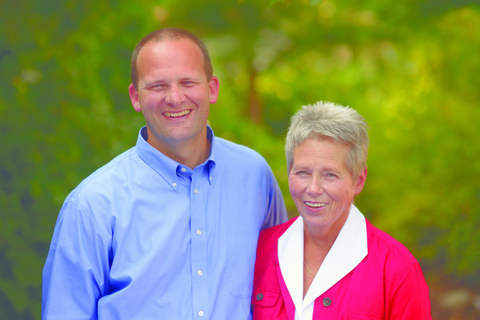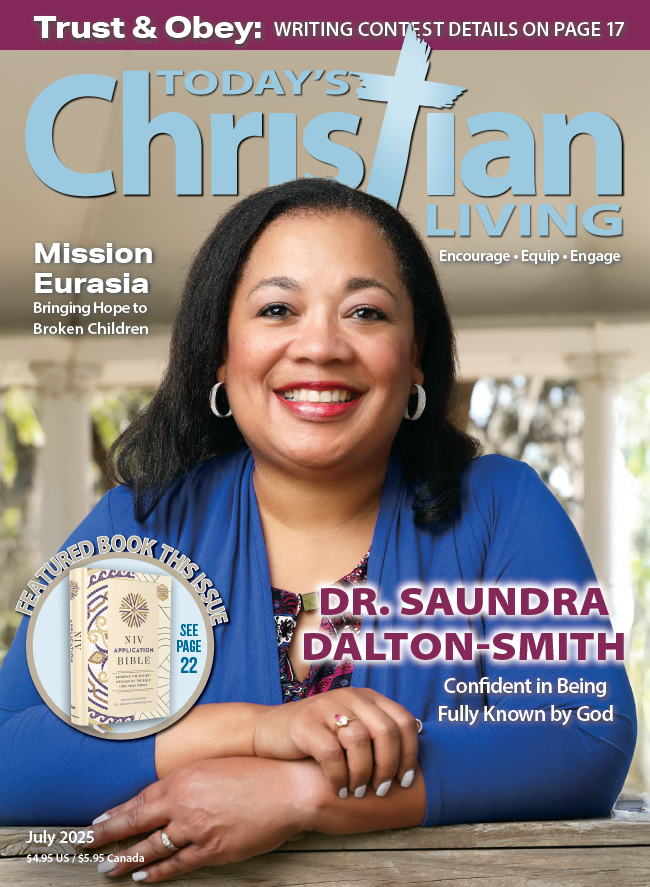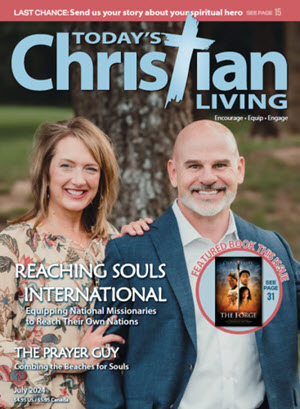
For years Stephen Owens hated his mother Gaile for the murder of his father. Meanwhile, Gaile repented in prison and faithfully served the Lord for many years while on death row. After Stephen learned of her repentance, he forgave her and the two reconciled. Photo by Peggy Napier
Sentenced to Death
Barbed wire.
I couldn’t take my eyes off the barbed razor wire atop the chain link fence surrounding the prison complex, as my wife Lisa and I drove onto the property of the Tennessee Prison for Women.
My mom, Gaile Kirksey Owens, had been incarcerated in this prison facility since February 21, 1986. It was now August 2009 and I had not seen her face since I had testified against her in court more than twenty-three years earlier and had helped the prosecutors convict her of parricide, “accessory before the fact to first-degree murder,” for hiring a man to murder my dad. Although Mother had immediately confessed, there was good reason my testimony against her carried such weight, even as a mere twelve-year-old child. On that horrible night a few days after Valentine’s Day in 1985, I was the one who had discovered my dad facedown on the floor of our den, his head bludgeoned and bloody, beaten nearly to death with a tire iron, by a man whose horrific crime had originated in the heart and mind of my own mother.
Dad died a few hours later, and Mother and her accomplice were apprehended and indicted the following week. For the next quarter of a century, I had nothing to do with her. I didn’t see her, rarely spoke with her, and did not write to her until after Lisa’s and my first child was born. For most of that time, although I knew she was in prison, because of my own anger and bitterness toward her, I did not even know my own mother’s whereabouts. Nor did I care. Not that she would have been hard to find. Since the day she was sentenced and transferred from jail to prison, Mother had lived on “death row” in the same facility, scheduled to be the first woman executed in Tennessee in more than 189 years.
Life in the Hole
After about eight months in prison, Mother resigned herself to the fact that nothing was going to change; she was living the life she would live till the day she died.
She beat herself up constantly, wondering, “Will I ever be loved again?” She could not imagine anyone else loving her when she could not even love herself. During the long, lonely hours, Mother had nothing but time, so she began to read the Bible. She had made a commitment to Jesus Christ as a child, but she really didn’t have a solid relationship with Him. Most of her religious experience had been steeped in legalism—keep the rules, and everything will be fine. Break the rules, and reap the consequences.
After about a year in prison, the numbness wore off, reality set in, and Mother began to weep. By now she had learned that tears can be dangerous in prison, exposing a certain vulnerability, but no matter how hard she tried, she couldn’t contain the tears.
New Life in Christ
One morning, Mother woke up and began crying and kept on crying. She cried almost nonstop for nearly eight hours. Lying on the floor, she called out to God, begging for His forgiveness. Though nothing about her circumstances changed, this was a turning point in Mother’s life. She knew she could not bring Dad back or make everything okay, but she truly believed that God forgave her. Although she had little hope of ever being released from prison, and no assurance that she’d ever see Brian or me again, she at least had the hope that when she was executed, she would wake up in heaven.
In 1987, Mother was given a prison job, doing paperwork in a property cage, while two other inmates stocked the shelves. Other than the prison officers, the two inmates from the general population were the first and only other human contact Mom had for nearly a year. For the first six years of her sentence, Mother was kept in the segregated section of the prison known as Unit 2.
Finally, she received a policy exemption that allowed her to live among the general population of the prison. Mom flourished, and became a trusted “employee” doing clerical work. It was the first time she had ever touched a computer and she was excited to learn a new skill.
During the next ten years, Mom moved with ease among the general population of the prison and became a quiet and dependable “favorite” of staff and inmates alike. She was elected to the Inmate Council and met monthly with the prison officials, serving as the elected voice of her fellow inmates. She also served on the Grievance board, a position nominated by inmates and selected by prison staff members.
A Beloved Inmate
Mom not only became a model prisoner; she became one of the most beloved inmates in the facility. She was known for helping the younger women adapt, and diffusing difficulties among older inmates. At the time Mom arrived at TPW, the average age of the inmates was 32.4 years old; over the years, the age of the new inmates dropped dramatically, with many under the age of twenty-five. Juvenile young women were incarcerated at TPW as well, although they were kept in lock down, isolated from the main population until the girls turned eighteen. They were then thrust into the general population. If the teenagers weren’t angry when they arrived at TPW, after spending a year or two or more in isolation, they would be, and then they were unleashed to the wolves.
Mom became a mentor and an encourager to many of the younger inmates.
“I just can’t do this time.”
“How much time have you got, honey?” Mom asked.
“Two years.”
“Two years? It’s going to be over before you know it.”
“Well, Miss Gaile, how long have you been here?”
“Ten years . . . fifteen years . . . twenty years. . . .”
Mom’s attitude was: Your time in prison is what you make it. And she wanted to make it productive. She lived each day with the hope that she would either walk out of prison or she would go to heaven from TPW. The death penalty hanging over her head could easily have fostered within her a “Who cares?” attitude, but Mother fought against it. Even when things didn’t go her way, she held her tongue.
“Why don’t you just go ahead and cuss them out?” some of her fellow inmates asked. “What do you have to lose?” implying that she was going to die anyhow. What did it matter? But to Mother, it mattered.
First Visit with Mother in Prison
We approached the gates and quickly discovered that the prison staff was expecting us. We got the feeling that they wanted to facilitate our visit with the least amount of interference. The warden met us at the first checkpoint. The guards nodded politely to us as we walked through the fencing and waited until we were called inside. We signed in, went through a metal detector, were patted down, and stood at the sliding doors that led to the prison.
The moment Lisa and I entered the room was an overwhelming experience for me. There, sitting demurely though nervously at the table was my now gray-haired mother whose face I had not seen in nearly twenty-four years. My eyes locked onto hers and without the slightest bit of hesitation, I opened my arms and moved in her direction. She rose from her chair, and I hugged my mother for the first time in twenty-five years, the last hug we shared being shortly after Dad’s funeral.
Mom sobbed openly. “I’m sorry, son,” she said as I held her close with her face buried in my shoulder. “I’m so sorry, son.” No further explanation was needed. Nobody had to ask, “For what specifically are you sorry?” We all knew. As I later described that moment, it was a raw apology filled with raw emotion, and I accepted it for what it was.
All too soon, time slipped away, and I sensed urgency. The most important reason for my visit had not been fulfilled. I had been convinced that God was leading me to prison to extend forgiveness to my mother, to tell her that I forgave her. I kept waiting for that opportunity to present itself.
Finally, the guard returned and gave us the five-minute-warning, five minutes before Mother would return to death row, five minutes before we would be ushered out of the prison confines, with no guarantee we would ever return. Mother acknowledged the guard, and then turned toward me, with tears quickly welling in her eyes. “I’m sorry, Stephen,” she said again. “I know I can’t change anything now, but I just need to ask for your forgiveness.”
This was it. This was the open door I had been hoping for, praying for, believing that it would nudge open if only slightly. This was what I believed God had sent me to do. I looked my mother in the eyes, and said, “I forgive you, Mom.”
Eligible for Parole
We received a call on the morning of July 14 that Governor Bredesen was holding a press conference to announce his decision. Gretchen and Kelly [two of Gaile’s attorneys] hurried to get from their Nashville office on 9th Avenue and Broadway to the Tennessee State Capitol building, a few blocks away. They called me on my cell phone and told me the governor would be announcing his decision in the next few minutes. I was driving the car when I received the call, and nearly drove off the road. The attorneys said they would call me back as soon as they knew anything. Gretchen and Kelly trembled as they held hands in the car on the way. This was it. Is she going to live or die?
Calling the case “complex and emotional,” the governor cited the “extraordinary” sentence rendered in the case and the fact that Owens had accepted a conditional plea agreement prior to her trial. “Nearly all the similar cases have resulted in life-in-prison sentences.” Bredesen advised George [also one of Gaile’s attorneys] that he was commuting the death sentence. And she would further receive one thousand days of sentence credit—“considerably less” than she would have earned had her original sentence been life imprisonment. Gaile would therefore be eligible for parole in late spring 2012.
The decision came out on the morning of September 28, 2011, three weeks to the day after the parole hearing, one year to the day after Mom would have been executed, had Governor Bredesen not commuted her sentence, and oh, yes, on Gretchen and Rich’s anniversary.
It was as though God was saying, “I want you to notice Who is in charge here.”

John Seigenthaler, who played a key role in Gaile’s release from prison, leads a public forum with Stephen Owens and Gaile Owens in Nashville on October 3, 2013. Photo courtesy of David Schroeder.
Two Lives Set Free
Forgiveness is not always easy. Some people want to give the impression that for those of us who trust in Jesus Christ, forgiveness and reconciliation are natural. Maybe that’s true for some people, but that has not been so for me.
Holocaust survivor Corrie ten Boom once said, “Forgiveness is to set a prisoner free, and to realize the prisoner was you.” I would concur.
What I’ve come to realize is that Gaile Owens was not the only member of our family imprisoned for more than a quarter of a century. I was equally as bound and shackled by my bitterness, anger, and the broken trust that decimated my life that night in 1985 when I found my dying father. The seething resentment I felt toward my mother for all those years continued to smolder, like hot lava beneath the surface of a volcano, and could have destroyed my life had I not been willing to forgive. Had I ignored forgiveness, either for my mother or myself, I would have continued to go through life dragging a ball and chain. But I thank God every day that my mother has been set free, from prison and from the past. And I thank God that I have been set free, as well.
Excerpted from Set Free by Stephen Owens and Ken Abraham. Copyright 2013 B&H Publishing Group. ww.bhpublishinggroup.com.
Stephen Owens lived with his aunt following the death of his father and incarceration of his mother. He graduated from the University of Memphis, earned a master’s degree from Middle Tennessee State University, and enjoys a successful teaching career. He lives with his wife and two sons near Nashville. www.stephen-owens.com @StephenROwens
Ken Abraham is a New York Times best-selling author known for getting “more heart on paper than any other cowriter in America” in books with 9/11 United Flight 93 widow Lisa Beamer (Let’s Roll!), financial expert Dave Ramsey, action hero Chuck Norris, astronaut Buzz Aldrin, and others. http://www.kenabrahambooks.com
To learn about the full story behind Gaile’s crime, imprisonment, conversion and eventual reconciliation with her son, read Set Free: Discover Forgiveness Amidst Murder and Betrayal, available at scl.christianbook.com








